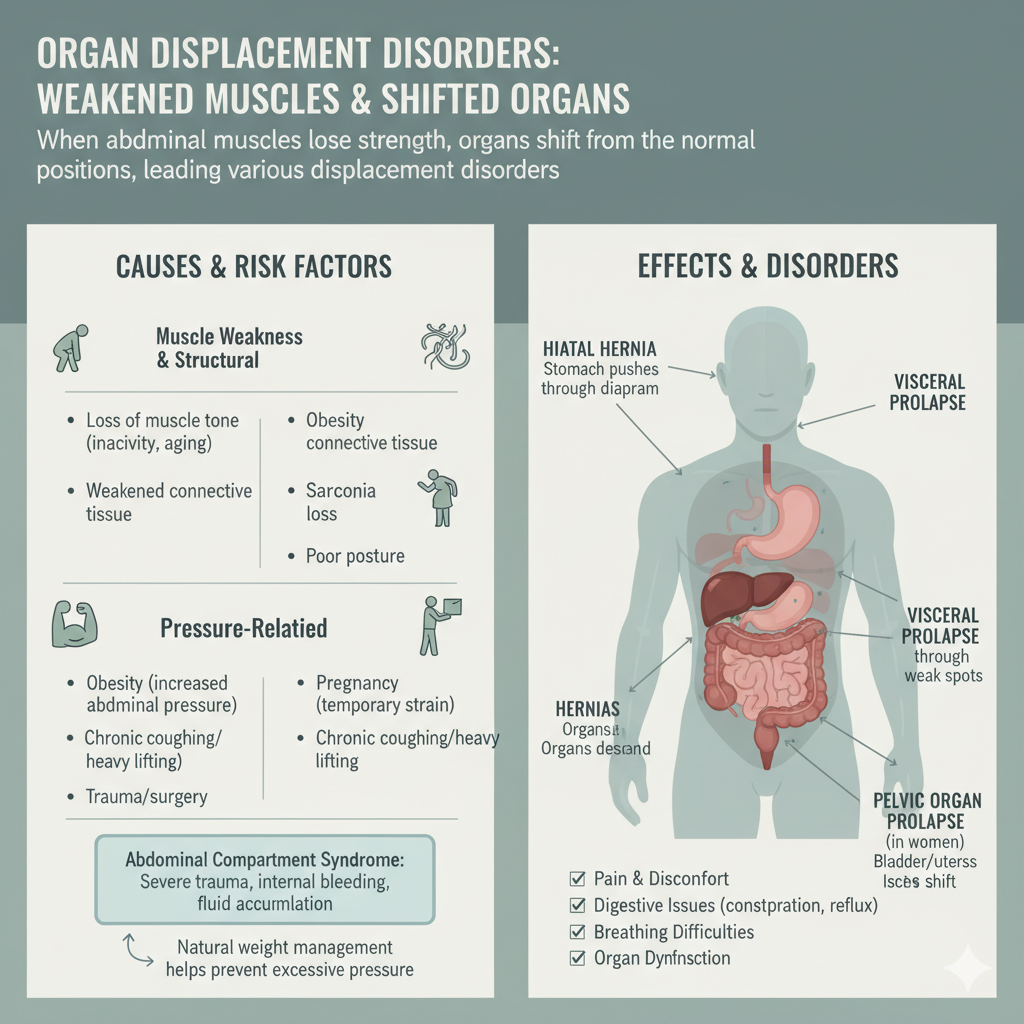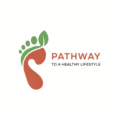Understanding Organ Displacement Disorders: How Weak Muscles Affect Your Health
Have you ever wondered what happens when the body’s organs shift from their normal position? Organ displacement disorders can quietly affect how we breathe, digest, and even move. From hernias to abdominal compartment syndrome, these conditions reveal how vital our internal muscle support system is. Weak abdominal and trunk muscles are more than a cosmetic concern—they’re often early signs of deeper issues linked to pressure changes, pain, and poor organ function. Understanding the effects of organ displacement and the causes of abdominal compartment syndrome helps us protect not only our core strength but our overall health.
What Are Organ Displacement Disorders?
Organ displacement disorders occur when an internal organ moves from its naturally protected, compact position within the body. These displacements happen when the abdominal muscles lose their supportive power, causing the whole system of organs that rest on them to become separated, elongated, and unsupported.
When abdominal muscles weaken, the stomach begins to draw from above instead of resting securely on the organs beneath. This creates what many describe as “a feeling of emptiness” at the center of the chest—a sensation of pulling downward at the pit of the stomach. Common examples of organ displacement include:
- Hernias: organs protruding through weak spots in the abdominal wall
- Diaphragmatic hernias: stomach pushing through the diaphragm opening
- Organ prolapse: pelvic organs dropping from their normal position
- Situs inversus: rare mirroring of organ positions established during embryonic development
The displacement of the stomach, liver, and spleen interrupts their normal functions, frequently resulting in digestive difficulties and compromised organ performance.
Causes and Risk Factors: Why Organs Move from Their Normal Position
Several factors contribute to organ displacement, most centering on weakened muscle support and increased internal pressure:
Muscle Weakness and Structural Causes:
- Loss of abdominal muscle tone from inactivity or aging
- Weakening of connective tissue that holds organs in place
- Sarcopenia (age-related muscle loss) reducing core stability
- Poor posture creating unequal pressure distribution
Pressure-Related Causes:
- Obesity increasing constant abdominal pressure
- Pregnancy placing temporary strain on abdominal structures
- Chronic coughing or heavy lifting
- Trauma or surgical complications

The causes of abdominal compartment syndrome specifically include severe trauma, internal bleeding, fluid accumulation following surgery, and conditions that rapidly increase pressure inside the abdominal cavity. Learning how natural weight management helps prevent excessive abdominal pressure becomes crucial for protecting organ stability.
Recognizing the Symptoms of Weak Internal Muscles
The symptoms of weak internal muscles often appear gradually before more serious displacement occurs:
Early Warning Signs:
- Dull, wandering pains in the abdomen or chest
- Sensation of pulling at the center of the chest
- Drawing or sinking feeling at the pit of the stomach
- Temporary relief when eating solid foods (which physically support the falling structures)
- Lower back pain and poor posture
- Abdominal bulging or visible weakness
- Difficulty taking deep breaths
Progressive Symptoms:
- Increased digestive discomfort and bloating
- Breathing becomes quicker and shorter
- Reduced lung capacity during physical activity
- Persistent fatigue and weakness
As the stomach and its connected organs fall downward, the diaphragm—along with the heart and lungs—must descend as well. In this compromised state, lung inflation receives less assistance from the abdominal muscles and becomes confined chiefly to the upper portion of the lungs. This mechanical restriction explains why people with weak core muscles often experience shallow breathing patterns.
Effects of Organ Displacement on Body Systems
The effects of organ displacement ripple through multiple body systems, creating interconnected health challenges:
Digestive System Impact
When organs shift from their optimal positions, digestive function suffers considerably:
- Stomach displacement leads to reduced digestive efficiency
- Interrupted food passage through compressed intestines
- Increased risk of gastroesophageal reflux (heartburn)
- Constipation from distorted intestinal positioning
- Inflammation and tissue stress from chronic pressure
In severe cases, the weight of unsupported organs pressing on the lower intestines creates unnatural and distorted positions. The passage of food becomes interrupted, and inflammations and constipation frequently result—affecting both men and women equally. Research has linked chronic digestive stasis from displacement to more serious ulcerative conditions in the stomach.
Respiratory System Complications
The lungs are particularly vulnerable to displacement effects:
- Reduced lung expansion when the diaphragm is pushed upward
- Decreased oxygen exchange capacity
- Shortness of breath during normal activities
- In severe trauma, pneumothorax (collapsed lung) from displaced air
According to findings in the Pelvic Cross Section Study, the trunk and hip muscles play a crucial role in supporting internal organ stability—highlighting why respiratory function depends heavily on proper core muscle strength.
Musculoskeletal System Strain
Weakened muscles and displaced organs create a cascade of structural problems:
- Chronic back pain from compensatory posture changes
- Loss of muscle mass (sarcopenia) accelerating the displacement cycle
- Spinal stress from uneven weight distribution
- Reduced mobility and increased injury risk
The heart also experiences stress from displacement. Palpitations, fluttering sensations, and feelings of instability all indicate that the cardiovascular system struggles when organs shift from their proper positions.
Circulatory Complications
When organs move abnormally, they can:
- Compress blood vessels, reducing blood flow (ischemia)
- Create pressure on nerves, causing referred pain
- Restrict organ function through inadequate oxygen supply
- In severe cases, contribute to tissue damage
Understanding Abdominal Compartment Syndrome
Abdominal compartment syndrome (ACS) represents one of the most serious organ displacement disorders. This condition occurs when increased pressure inside the abdomen reduces blood flow to vital organs, creating a medical emergency.
The causes of abdominal compartment syndrome include:
- Severe trauma with internal bleeding
- Massive fluid accumulation after surgery
- Swelling from severe infections
- Rapid fluid resuscitation in critical care
- Large intra-abdominal tumors or masses
When pressure inside the abdominal cavity rises sharply, it pushes the diaphragm upward, compressing the lungs and limiting their ability to expand. This restriction causes shortness of breath and dangerous drops in oxygen levels. Without prompt treatment, ACS can progress to Multiple Organ Dysfunction Syndrome (MODS)—a life-threatening condition where two or more organ systems begin failing simultaneously.
Special Considerations: Hiatal Hernia and Displacement Patterns
A hiatal hernia occurs when the upper portion of the stomach pushes through the diaphragm’s natural opening into the chest cavity. This displacement pulls the lower esophageal sphincter out of position, causing:
- Gastroesophageal reflux disease (GERD)
- Chronic heartburn and regurgitation
- Difficulty swallowing
- In large hernias, compression of lungs and heart
- Rarely, stomach twisting (volvulus) requiring emergency intervention
Risk factors mirror other displacement disorders: obesity, pregnancy, chronic cough, heavy lifting, and weakened connective tissue—often worsening with age. Modern clothing choices that constrict the abdomen can also contribute to increased internal pressure over time.
Gender-Specific Impact and Prevention
While both sexes experience organ displacement, certain patterns affect women disproportionately due to pelvic anatomy and pregnancy-related changes. The pressure of displaced organs on pelvic structures can cause significant discomfort, particularly given the intimate connection between these organs and the nervous system.
However, modern lifestyle factors—including tight belts and restrictive clothing around the waist—increasingly affect men as well, creating similar displacement risks through chronic abdominal compression. Learn more on our blog on the connection between clothing and health.
Prevention and Management Strategies
Protecting yourself from organ displacement disorders requires a multifaceted approach:
Strengthen Your Core:
- Practice targeted abdominal and back exercises
- Engage in regular physical activity to prevent sarcopenia
- Work with professionals for proper form and progression
Manage Internal Pressure:
- Maintain healthy body weight to reduce constant abdominal stress
- Use proper lifting techniques for heavy objects
- Address chronic cough through appropriate medical treatment
Support Structural Health:
- Practice good posture throughout your daily activities
- Choose clothing that doesn’t constrict the abdomen
- Ensure adequate nutrition for muscle and connective tissue health
- Include foods rich in protein and collagen-supporting nutrients
Breathing and Awareness:
- Practice deep breathing exercises to strengthen the diaphragm
- Pay attention to early symptoms of weak internal muscles
- Seek professional evaluation if you notice persistent discomfort or unusual sensations
When to Seek Medical Attention
Certain symptoms require prompt medical evaluation:
- Sudden, severe abdominal pain or distension
- Difficulty breathing or rapid heart rate
- Visible bulging or protrusion in the abdomen
- Persistent digestive problems or unexplained weight loss
- Progressive weakness or inability to perform normal activities
Early detection and intervention can prevent minor displacement from progressing to serious complications like abdominal compartment syndrome or chronic organ dysfunction.
Conclusion: Protecting Your Internal Support System
Understanding organ displacement disorders empowers you to protect your health through informed choices. The effects of organ displacement extend far beyond cosmetic concerns—they impact breathing, digestion, circulation, and overall vitality. By recognizing the symptoms of weak internal muscles early and addressing the causes of abdominal compartment syndrome through preventive measures, you maintain the structural integrity that keeps your organs functioning optimally.
Your abdominal and trunk muscles serve as the essential foundation supporting every internal organ. Strengthening this foundation through proper exercise, weight management, and healthy lifestyle habits ensures your organs remain in their natural positions—where they can perform at their best for lifelong health.
The Fascinating Body Revelation
Did you know your organs subtly shift every time you breathe or change posture? Even the smallest imbalance in your abdominal strength can ripple through your body like a silent chain reaction—affecting digestion, mood, and even oxygen flow. The body speaks in whispers before it ever shouts in pain; the key is learning to listen before imbalance turns into illness.
